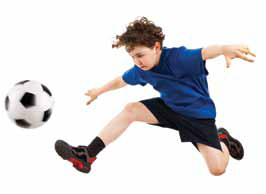
Your preteen soccer player comes home from practice complaining of knee pain, and there is a tender swelling at the top of his shin. Your 8-year-old starts limping and talking about a gradually increasing ache in his heel.
In both cases, the culprit may be apophysitis, a relatively common condition where an apophysis—a type of growth plate where muscles attach—becomes inflamed. This occurs because of increasing tension on the apophysis during rapid growth spurts caused by the differing growth rates of muscles, tendons and bones.
When children engage in activities that cause repetitive strain or overuse, the apophysis may not be able to take the additional stress, which leads to discomfort and a decreased range of motion in the affected area of the body. Young athletes are particularly prone to apophysis, as are children with muscle weakness or balance issues. Apophysitis typically occurs between the ages of eight and 18. It can strike any part of the body where a tendon attaches to a site of bone growth, but the most common locations are the patellar tendon of the knee and the Achilles tendon in the heel.
Treatment depends on the child’s age, activity level and a variety of other factors. While in extreme cases surgery may be advised, most children will simply be instructed to
- rest
- scale back on physical activity
- take anti-inflammatory pain medications (if your child’s physician approves)
- engage in a physical therapy program tailored for their developmental needs
There is some controversy over whether it is better to treat apophysitis with activity modification and rest or to focus more on building strength and flexibility to correct any biomechanical problems that may have led to the issue in the first place. Regardless of your physician’s philosophy, a good physical therapy plan can be key to your child’s recovery and eventual return to sports.
We can design an individualized program tailored to your child’s particular needs. With rest, activity modification, monitoring and an exercise program to improve flexibility and strength, your young athlete can soon be back in the game.
